
Vaccinium vitis-idaea, the lingonberry, partridgeberry, mountain cranberry or cowberry, is a small evergreen shrub in the heath family Ericaceae, that bears edible fruit. It is native to boreal forest and Arctic tundra throughout the Northern Hemisphere, from Europe and Asia to North America. Lingonberries are picked in the wild and used to accompany a variety of dishes in Northern Baltoscandia, Russia, Canada and Alaska. Commercial cultivation is undertaken in the U.S. Pacific Northwest and in many other regions of the world.

The geometer moths are moths belonging to the family Geometridae of the insect order Lepidoptera, the moths and butterflies. Their scientific name derives from the Ancient Greek geo γεω, and metron μέτρον "measure" in reference to the way their larvae, or "inchworms", appear to "measure the earth" as they move along in a looping fashion. A very large family, it has around 23,000 species of moths described, and over 1400 species from six subfamilies indigenous to North America alone. A well-known member is the peppered moth, Biston betularia, which has been subject of numerous studies in population genetics. Several other geometer moths are notorious pests.
In Greek mythology, two sacred mountains are called Mount Ida, the "Mountain of the Goddess": Mount Ida in Crete, and Mount Ida in the ancient Troad region of western Anatolia, which was also known as the Phrygian Ida in classical antiquity and is mentioned in the Iliad of Homer and the Aeneid of Virgil. Both are associated with the mother goddess in the deepest layers of pre-Greek myth, in that Mount Ida in Anatolia was sacred to Cybele, who is sometimes called Mater Idaea, while Rhea, often identified with Cybele, put the infant Zeus to nurse with Amaltheia at Mount Ida in Crete. Thereafter, his birthplace was sacred to Zeus, the king and father of Greek gods and goddesses.

Mount Ida is a mountain in northwestern Turkey, some 20 miles southeast of the ruins of Troy, along the north coast of the Gulf of Edremit. The name Mount Ida is the ancient one. It is between Balıkesir Province and Çanakkale Province.

The small dusty wave is a moth of the family Geometridae first described by Franz von Paula Schrank in 1802. It is found throughout Western, Central and Northern Europe. In the north, its range extends as far as Denmark and southern Scandinavia. In the east its range extends as far as Russia. Idaea seriata is replaced by the subspecies Idaea seriata canteneraria, from the north-east of Spain and the central and eastern Mediterranean to the Crimean peninsula, while the western Mediterranean and the Balearic Islands are inhabited by the sister species Idaea minuscularia. Outside Europe it is found in eastern Algeria, Tunisia, Turkey, Cyprus, the Caucasus and the northwest of Transcaucasia. In Morocco and western Algeria, it is replaced by the sister species Idaea minuscularia. In the British Isles it is common in England and Wales but is only found in the eastern half of Scotland and it is rare in Ireland.
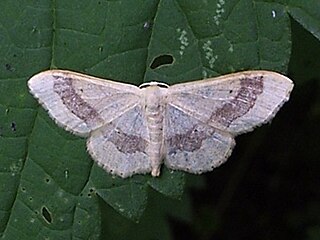
The riband wave is a moth of the family Geometridae. The species was first described by Carl Linnaeus in his 1758 10th edition of Systema Naturae.

Idaea, sometimes called Hyriogona, is a large genus of geometer moths. It was erected by Georg Friedrich Treitschke in 1825. They are found nearly worldwide, with many native to the Mediterranean, the African savannas, and the deserts of western Asia.
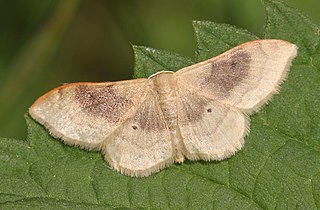
Idaea degeneraria, the Portland ribbon wave, is a moth of the family Geometridae. The species was first described by Jacob Hübner in 1799.

Idaea inversata, the purple wave, is a moth of the family Geometridae. The species was first described by Achille Guenée in 1857. It is found along the east coast of Australia.
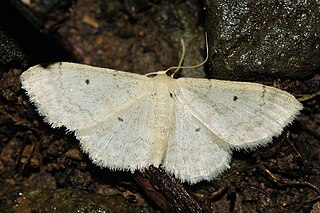
Idaea mancipiata is a moth of the family Geometridae. It is found in Europe und western Asia.
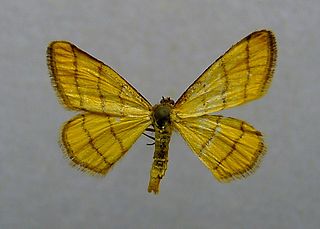
Idaea aureolaria is a species of moth of the family Geometridae. It is found from Spain and France through central Europe to the Balkan Peninsula and east to Siberia. It is also found from Turkey to Central Asia.
Idaea or Idaia is the name of several figures in Greek mythology, it means "she who comes from Ida" or "she who lives on Ida", and is often associated with Mount Ida in Crete, and Mount Ida in the Troad.
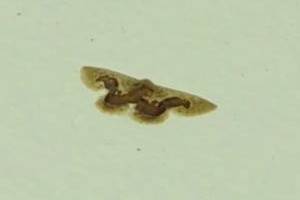
Idaea gemmaria is a moth of the family Geometridae first described by George Hampson in 1896. It is found in Sri Lanka.
Idaea marcidaria is a moth of the family Geometridae first described by Francis Walker in 1861. It is found in Sri Lanka, Myanmar, China, Taiwan, Singapore and Borneo.
In Greek mythology, Idaea or Idaia was a nymph, presumably of Mount Ida in the ancient Troad region of western Anatolia. She was the mother, by the river-god Scamander, of Teucer, who was the first to rule as a king over the region known later as Troy.
In Greek mythology, Idaea or Idaia was, by some accounts, the daughter of the Scythian king Dardanus, and the second wife of Phineus, the king of Thrace. Idaea's false accusations against her stepsons were responsible for her husband's misfortunes. She was sent back to Scythia, where she was condemned to death. Other ancient sources give other names for Phineus' second wife, including: Eidothea, sister of Cadmus, and Eurytia.










